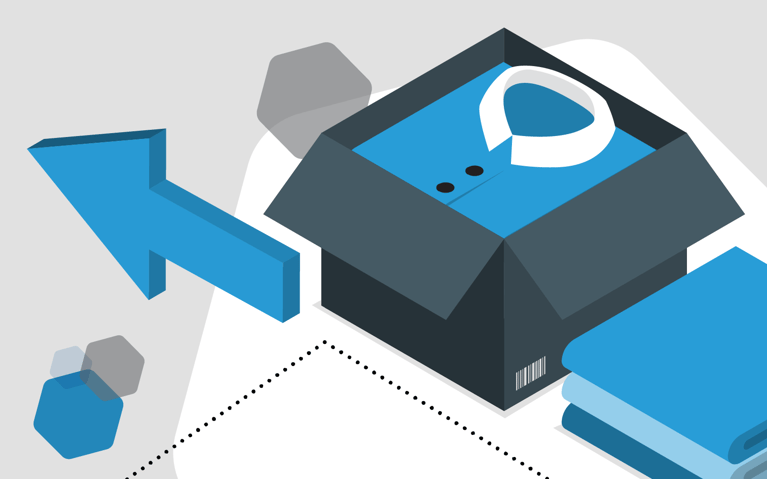Originally posted 7/25/2023, updated 12/31/2024 by D. Shaffer.
Efficient shipping is integral to ecommerce success, and shipping zones are pivotal in this process. These zones determine shipping rates and delivery times, impacting operational costs and customer satisfaction. For businesses looking to stay competitive, mastering the intricacies of shipping zones is crucial. By understanding how zones influence logistics, brands can craft strategies that minimize expenses, enhance delivery efficiency and delight customers.
The following guide breaks down everything you need to know about shipping zones, from their structure to optimization tactics, empowering businesses to leverage them effectively.
What are shipping zones?
Shipping zones are geographical areas carriers use to calculate shipping rates based on the distance from the point of origin to the delivery destination. Essentially, they help carriers standardize pricing and delivery times across various locations.
Shipping zones are not fixed regions but are determined by the distance a package travels. Each zone reflects an approximate range of miles from the shipment’s origin. For example, Zone 1 includes local shipments within 50 miles, while Zone 8 covers distances over 1,800 miles.
Understanding these zones allows businesses to estimate better shipping costs and delivery times, which are crucial for planning and customer satisfaction. Here’s an example of how zones are broken down (the exact mileage and definitions may vary slightly depending on the carrier):
|
Zone |
Mileage from Point of Origin |
|
Zone 1 |
0-50 miles |
|
Zone 2 |
51-150 miles |
|
Zone 3 |
151-300 miles |
|
Zone 4 |
301-600 miles |
|
Zone 5 |
601-1,000 miles |
|
Zone 6 |
1,001-1,400 miles |
|
Zone 7 |
1,401-1,800 miles |
|
Zone 8 |
Over 1,800 miles |
Why do shipping zones matter in ecommerce?
Shipping zones significantly influence shipping costs, delivery times and the overall success of ecommerce operations. For instance, consider a business aiming to serve customers nationwide – shipping zones determine how cost-efficiently and quickly orders can be fulfilled. These zones impact operational strategies and key decisions, including pricing structures and warehouse locations. Companies that understand and optimize shipping zones stand to save on logistics expenses while boosting customer satisfaction.
Impact on shipping costs and delivery times
The distance between the point of origin and the destination directly affects the shipping cost. Packages traveling to higher-numbered zones require more resources, such as fuel and time, leading to increased costs. Additionally, delivery times are longer for packages traveling to farther zones, which can influence customer satisfaction. For example, a Zone 2 shipment may arrive in 1-2 days, while a Zone 8 package could take up to a week.
Relevance to profitability and customer satisfaction
For eCommerce businesses, balancing shipping costs with profitability is crucial. Overestimating costs can deter customers, while underestimating may result in financial losses. Furthermore, quick and affordable shipping options, particularly for lower zones, often lead to better customer experiences and repeat business. Organizations can maintain profitability while keeping customers satisfied by understanding and optimizing zones.
How do shipping zones affect fulfillment costs?
Shipping zones play a direct role in determining fulfillment costs, including carrier fees and operational expenses. Below is a detailed breakdown:
Breakdown of typical costs by zone
Each shipping zone corresponds to a different cost tier. For example, Zone 2 shipments, being close to the origin, incur minimal fuel and transit expenses. In contrast, Zone 8 shipments often include additional fees for fuel surcharges and extended delivery routes. Understanding the cost variance across zones can help businesses price their products appropriately and choose the best carriers for specific regions.
How to calculate shipping costs with shipping zones
Shipping costs are calculated by identifying the zone of the delivery address and referencing the carrier’s pricing structure. Businesses must also consider factors like package weight and size, which interact with zone-based pricing. For instance, a 2-pound package shipped to Zone 3 may cost less than the same package sent to Zone 7 due to the additional distance and resources required.
Carrier pricing structures
Each major carrier structures its pricing based on zones. USPS offers flat-rate options but adjusts pricing significantly by weight and zone for other services. UPS applies surcharges for remote areas in higher zones, while FedEx provides flexible options that vary by zone and delivery speed.
Comparing these structures helps businesses choose the most cost-effective carrier.
|
Carrier |
Zone-Based Pricing Characteristics |
|
USPS |
Flat-rate options are available, but weight and zone heavily influence costs. |
|
UPS |
Rates vary widely by zone, but can include additional surcharges for remote areas |
|
FedEx |
Zone-based pricing with flexibility in delivery speed options |
What strategies can ecommerce brands use to optimize shipping zones?
Ecommerce brands can employ several strategies to mitigate the impact of shipping zones on costs and delivery times, including:
- Choosing warehouse locations: Strategically locating warehouses can significantly reduce shipping costs and delivery times. By analyzing customer demographics and sales data, companies can identify high-demand regions and position warehouses nearby. For example, placing warehouses on both coasts allows for efficient coverage of large population centers while minimizing high-zone shipments to distant locations.
- Partnering with a 3PL: Partnering with a 3PL enables ecommerce businesses to distribute inventory strategically across various zones, reducing long-distance shipments and overall shipping costs. Additionally, 3PLs often have established relationships with carriers, which can lead to cost savings.
- Balancing costs and delivery speed: Offering tiered shipping options, such as standard and expedited shipping, allows customers to choose based on their priorities. While expedited shipping may cost more, it satisfies customers who prioritize speed. For standard shipments, focusing on minimizing high-zone deliveries can balance costs and maintain reasonable delivery times.
What tools or technology can help brands manage shipping zones more effectively?
Managing shipping zones effectively is crucial for optimizing logistics and reducing costs. Leveraging the right tools and technology, such as Transportation Management Systems (TMS) and carrier zone mapping tools, can streamline operations and improve decision-making. These solutions provide valuable insights and automation, making it easier for businesses to manage complex shipping requirements.
Transportation management system software
A Transportation Management System (TMS) is essential for managing shipping zones efficiently. These systems automate processes like route optimization, carrier selection and cost calculation. By leveraging a TMS, businesses can:
- Streamline logistics
- Reduce errors
- Gain insights into shipping performance
- Improve decision making
Carrier zone mapping tools
Carrier zone mapping tools provide visual representations of shipping zones and their associated costs. These tools help businesses analyze shipping data, identify cost-saving opportunities and make informed choices about carrier selection and warehouse placement. They are particularly useful for scaling businesses with high shipment volumes across diverse locations.
How do shipping zones differ across major carriers?
Shipping zones are consistent in concept but vary in execution among carriers. Here are a few key differences:
|
Carrier |
Pricing Model |
Delivery Timeframe |
|
USPS |
Affordable for light packages in low zones. |
Priority Mail: 1-3 days in Zones 1-4 |
|
UPS |
Premium for faster services in high zones. |
Ground Shipping: 1-5 days nationwide |
|
FedEx |
Flexible options for express and ground. |
Express: 1-2 days; Ground: 1-5 days |
For example, USPS is often cost-effective for smaller, lower-zone packages, while UPS and FedEx excel in reliability and speed for high-zone shipments. Understanding these differences enables businesses to select the right carrier for their needs.
Optimizing ecommerce fulfillment with Cart.com
Shipping zones are a critical element of ecommerce logistics. By understanding their impact and using tools like TMS and 3PL partnerships, businesses can streamline operations, reduce costs and improve customer satisfaction. Contact our team today to discover how we help our partners take a strategic approach to managing shipping zones that can turn logistics challenges into opportunities for growth.
Subscribe to our emails for the latest industry insights!
By entering your email, you agree to receive marketing emails from Cart.com







